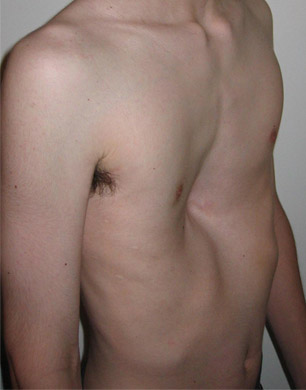Pectus excavatum facts for kids
Quick facts for kids Pectus excavatum |
|
|---|---|
| Synonyms | Funnel chest, dented chest, sunken chest, concave chest |
 |
|
| An example of an extremely severe case of pectus excavatum. | |
Pectus excavatum is a medical condition where a person's chest looks like it has caved in or is sunken. It happens because the ribs and breastbone (sternum) grow in an unusual way. People often call it "funnel chest" or "sunken chest." It's the most common type of chest wall difference.
This condition is present from birth, but it often becomes more noticeable as a child grows, especially during their teenage years when growth is faster. About 1 in every 300 to 400 babies are born with pectus excavatum. It is more common in boys than in girls.
Contents
What Causes a Sunken Chest?
Doctors are not completely sure why some people have pectus excavatum. They think it might be linked to a gene passed down from parents. It can also be connected to certain syndromes, which are other medical conditions that affect different parts of the body.
How Many People Have It?
Pectus excavatum affects about 1 in every 300 to 400 children. Most of the people who have it are boys.
Treatments for Pectus Excavatum
There are different ways to help fix a sunken chest. Some treatments do not involve surgery, while others do.
Using a Suction Cup
One way to treat pectus excavatum without surgery is by using a special suction cup, also called a vacuum bell. This cup is placed on the chest. Then, all the air is removed from the cup, which gently pulls the chest outwards.
This method can help correct the sunken appearance over time. To see lasting results, treatment usually needs to continue for about two years after the chest looks corrected.
Surgery Options
If the sunken chest is severe or causes problems, a doctor might suggest surgery. Here are two common surgical methods:
The Nuss Procedure
The Nuss Procedure was developed by Doctor Nuss. In this surgery, a small cut is made, and a metal bar is carefully placed inside the chest. This bar helps to push the breastbone forward and hold the chest in a better position. After a few years, the bar is removed.
The Ravitch Technique
The Ravitch technique was first used in the 1950s. This surgery involves removing some of the cartilage (soft bone) from the ribs. Then, a bar might be placed to help reshape the chest. The bone is allowed to grow back. This method is not used as often today because it can cause more bleeding than the Nuss procedure.
Images for kids
See also
 In Spanish: Pectus excavatum para niños
In Spanish: Pectus excavatum para niños






